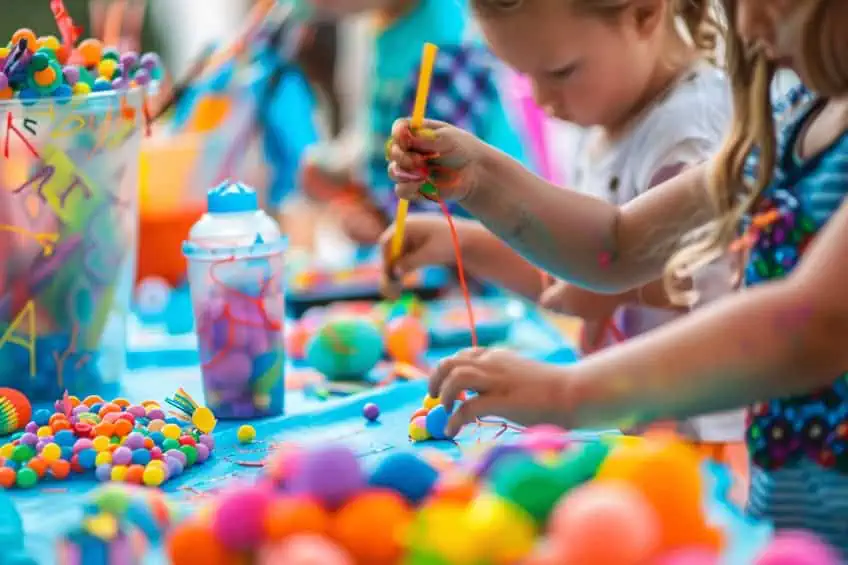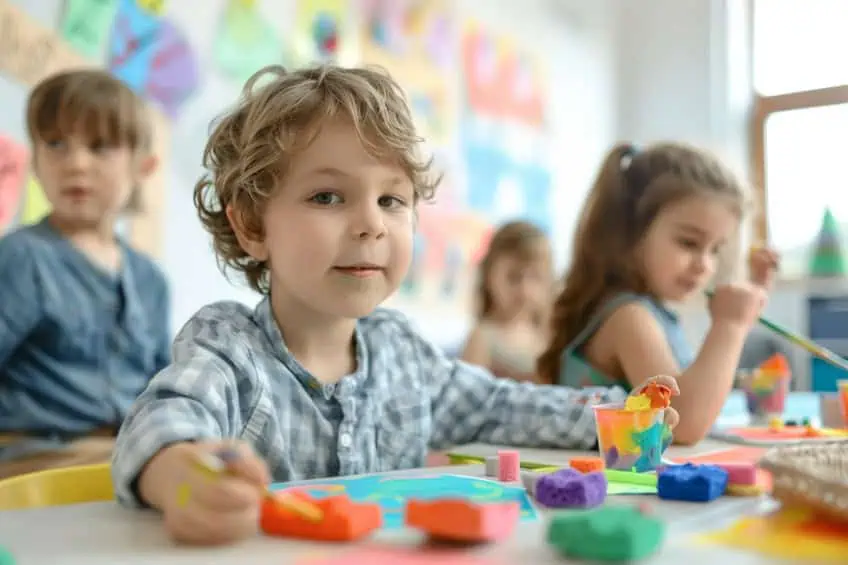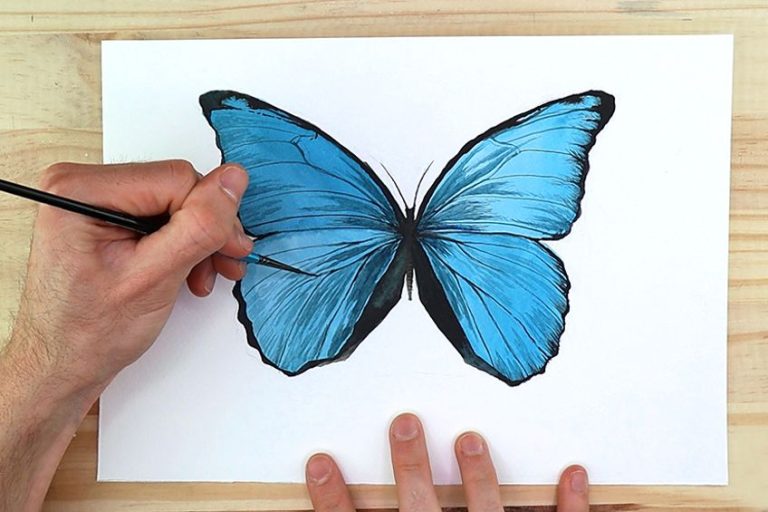Easy Painting Ideas for Kids – Art Projects for Little Painters
This post may contain affiliate links. We may earn a small commission from purchases made through them, at no additional cost to you.
Introducing children to the world of art through painting can be both enjoyable and educational! Through simple yet engaging painting ideas, children can explore their creativity, develop fine motor skills, and express their emotions. In this article, we’ll explore easy painting ideas tailored for kids, providing a gateway for them to discover the joy of creating art.
Table of Contents
Key Takeaways
- Painting is a fun and beneficial activity for kids.
- Different age groups can enjoy various painting techniques.
- Unique tools and materials keep painting projects engaging.
Fundamentals of Painting With Kids
Painting can be an amazing activity for kids that helps unleash their creativity while providing countless hours of fun. Whether it’s using watercolors, acrylics, or even homemade and edible paints, kids of all ages can engage in painting projects that are both simple and stimulating. The benefits of painting for children extend beyond just artistic skills, encompassing emotional, cognitive, and fine motor development. From toddlers to tweens, there’s a wide array of painting ideas that can cater to their varying interests and skill levels.

Simple projects like finger painting or using household items as unique painting tools can make the process exciting and accessible for young artists. As kids grow older, they can try more complex techniques like spin art or puffy paint, which add new dimensions to their creative exploration. Including painting activities for different seasons and holidays adds an extra layer of excitement to the projects. Exploring different materials and surfaces, such as using salt, bubbles, or even paper plates, keeps the activities novel and engaging.
These easy painting ideas are not only enjoyable but can also be done at home or in the classroom, making them versatile options for any setting.
Choosing the Right Materials
Selecting the best materials is crucial in making painting a fun activity for kids. There are several types of paints that are generally recommended for children:
- Acrylic paints: Ideal for older children who can handle permanent paints.
- Tempera paints: Best for younger children due to their washable nature.
- Watercolor paints: Great for all ages, especially for creating softer, more diluted effects.
Brushes of different sizes and sponges can help kids create various textures. Ensure that aprons and drop cloths are used to protect clothing and surfaces. Non-toxic and washable products are always the safest choices.

Setting Up a Kid-Friendly Painting Space
A well-organized space can make painting enjoyable and stress-free for both children and adults. Start by choosing an area that can easily be cleaned, like a kitchen or an outdoor space. Tables and chairs should be at a comfortable height for the children. Cover the working area with newspapers or plastic sheets to catch spills. Additionally, having a washing station nearby for quick clean-ups can be very helpful. Include all essential items within reach like paint pots, brushes, and cleaning supplies.
Storage solutions like cubbies or trays can keep materials organized and accessible.
Painting Techniques for Different Age Groups
Different age groups benefit from specific painting techniques. Toddlers can engage in sensory play through finger painting, preschoolers can explore dot painting and pointillism, and older children can try more advanced techniques.

Finger Painting and Sensory Play for Toddlers
Toddlers enjoy painting that stimulates their senses. Finger painting is perfect for this age group. It allows them to feel the cool, squishy paint between their fingers. Using edible paint ensures safety as many toddlers explore with their mouths. Bath paints and ice painting are also great sensory experiences. Bubble wrap painting can add texture and fun. Tape a piece of bubble wrap to a surface, let toddlers apply paint, and then press paper onto the bubble wrap to transfer the paint.
This activity helps develop fine motor skills and introduces cause and effect.
Exploring Pointillism and Dot Painting for Preschoolers
Preschoolers can start exploring basic art concepts like pointillism. Pointillism involves creating pictures with small dots of color. Using q-tips and different colors, they can paint simple shapes or pictures. This technique improves hand-eye coordination and patience.

Dot painting can be made more engaging by using different tools like cotton swabs, erasers of pencils, or even their fingertips. This method encourages creativity and precision. Bubble wrap can also be repurposed for dot painting, letting children create intricate designs with ease.
Advanced Techniques for Elementary and Middle Schoolers
Older children can try more advanced painting techniques. Splatter painting is one such method, where kids use brushes or other tools to flick paint onto a canvas. This messy but exciting technique allows them to understand abstract art and develop problem-solving skills as they experiment with patterns and colors.
Puffy paint can be created by mixing shaving cream, glue, and food coloring.
This paint adds a three-dimensional effect to their projects. Remote control vehicle painting is another creative technique where kids dip the wheels of toy vehicles in paint and drive them over paper, creating unique patterns and tracks. Among these activities, children learn to plan and execute ideas, fostering both their artistic and cognitive development.
Some Fun and Easy Painting Ideas
There are plenty of fun and easy painting activities for children that can spark creativity and provide a great way to spend time. Each idea is designed to be simple yet engaging, using everyday materials.

Fingerprint Art
Fingerprint art involves pressing fingertips onto a piece of paper to create designs. Kids can use different colors to make patterns or pictures. It is easy to set up and clean. The materials needed include:
- Non-toxic paints
- Paper or canvas
- Wet wipes for cleanup
Fingerprint art helps children learn about colors and patterns. They can create animals, trees, or abstract shapes. In addition to being fun, it also helps kids develop fine motor skills.
Sponge Painting
Sponge painting uses sponges to apply paint in unique ways. Children can dip sponges into paint and then press them onto paper for interesting textures. The materials needed include:
- Sponges cut into different shapes
- Paint
- Paper
Sponge painting is great for young children because sponges are easy to hold. Kids can experiment with various shapes and colors to create beautiful scenes. It is a fantastic way to introduce kids to the idea of texture in art.

Leaf Printing
Leaf printing involves using actual leaves to press paint onto paper. This activity teaches children about nature and art simultaneously. The materials needed include:
- Leaves of different shapes and sizes
- Paint
- Paper
To make a leaf print, children dip a leaf in paint and press it onto paper. The veins and shapes of the leaves create intriguing prints. Leaf printing is great for outdoor learning and seasonal projects.
String Painting
String painting uses pieces of string dipped in paint to make artwork. This technique creates unique lines and patterns. The materials needed include:
- String or yarn
- Paint
- Paper
Kids dip strings into different colors of paint and drag them across the paper. This creates interesting, abstract patterns. It is a fun way to explore movement and rhythm in art.

Handprint Animals
Handprint animals involve using handprints to create animal shapes. Each handprint can be turned into a cute animal with a few extra details. The materials needed include:
- Non-toxic paints
- Paper
- Markers or crayons for details
Children dip their hands in the paint and press them onto paper. Once the paint dries, they can add features like eyes, tails, and ears to turn handprints into animals. This activity combines imagination with physical activity, making it doubly fun for kids.
Creative Painting Projects and Ideas
Children can explore their creativity with unique painting projects that use natural elements, imaginative themes, and interactive techniques. These activities are both fun and educational, helping kids learn about art and the world around them.

Nature-Inspired: Leaf and Flower Painting
- Leaf painting: Leaf painting is a fantastic way for kids to learn about nature while being creative. Collect various leaves, dip them in paint, and press them onto paper to create colorful imprints. The different shapes and sizes of the leaves make each print unique. This project teaches about textures and patterns found in nature.
- Flower painting: Flower painting can be done by using actual flowers as brushes or stamps. Kids can dip flower petals in paint and press them onto paper, creating vibrant and colorful designs. This activity helps children appreciate the natural beauty of flowers and understand the concept of symmetry in nature.
Imaginative Activities: From Rock to Starry Night Canvases
- Rock painting: Rock painting is an exciting way to turn ordinary stones into works of art. Kids can paint faces, animals, or abstract designs on rocks. It promotes creativity and can also encourage storytelling as kids create characters on their rocks. Painted rocks can be used as decorations or as part of a collection.
- Starry Night canvases: Inspired by Vincent van Gogh’s Starry Night, this project allows kids to recreate the famous painting on their own canvases. Using swirls of blue, yellow, and white, children can mimic the starry sky. Glitter can be added to give the painting a magical touch. This helps kids learn about famous artworks and experiment with color blending.

Interactive Painting: Spin, Marble, and Pendulum Art
- Spin art: Using a power drill or a specially designed spin art machine, kids can create stunning designs. By placing a paper on the spinning platform and dropping paint on it, centrifugal force spreads the paint in unique patterns. Supervision is needed, especially for younger kids. This activity emphasizes the fun of experimentation and observation.
- Marble painting: For marble painting, place a paper in a tray, add a few drops of paint, and roll marbles around. The movement creates interesting lines and patterns. This method teaches kids about cause and effect as they observe how movement changes their artwork.
- Pendulum painting: With pendulum painting, children can use a suspended container filled with paint to create swinging patterns on a canvas below. By adjusting the pendulum’s length and the container’s height, different designs are produced. This activity combines art and science, demonstrating principles of motion and gravity.
Innovative Painting Ideas Using Unconventional Tools
Kids can explore their creativity by trying out painting techniques that use everyday items. These fun and unique methods help develop motor skills while making art more engaging and enjoyable.

Crafting With Q-Tips, Bubble Wrap, and Food Coloring
- Q-tip painting: This uses cotton swabs instead of brushes. Children can dip Q-tips into various colors and dot them on paper to create patterns or pictures. A popular project is the Q-Tip Painted Dragonfly Craft, where kids use Q-tips to add colorful details to dragonfly drawings.
- Bubble wrap painting: This involves dipping bubble wrap in paint and pressing it onto paper. This technique creates unique textures and patterns, making it perfect for backgrounds or abstract art.
- Food coloring: By using this in your art, you can add vibrant hues to paintings. By mixing food coloring with water in spray bottles, kids can spritz it onto paper for a splatter painting effect. Alternatively, they can create blow painting by blowing through a straw to spread the colors.
Fun With Bubble and Water Gun Painting
- Bubble painting: This combines bubbles with paint. Kids can mix water, paint, and a bit of soap, then blow bubbles into the mixture using a straw. When the bubbles pop on a sheet of paper, they leave behind colorful circles.
- Water gun painting: This uses toy water guns filled with diluted paint. Children can aim and spray their canvases, creating an exciting and dynamic work of art. This method is enjoyable and helps in developing coordination while making a masterpiece.

In both techniques, supervision is recommended to ensure safety, especially with younger children using straws, soap, or water guns. These activities not only make painting fun but also help in learning new, creative ways to make art.
Introducing children to easy painting ideas not only fosters their artistic skills but also nurtures their imagination and self-expression. Through these creative activities, children can learn about colors, shapes, and textures while gaining confidence in their abilities. Encouraging a love for art from an early age can inspire a lifelong passion for creativity and cultural appreciation. So let’s continue to nurture young artists and celebrate the endless possibilities that painting offers to children of all ages!
Frequently Asked Questions
What Are Some Simple Painting Activities for Seven-Year-Old Children?
Children aged seven can enjoy activities like cherry blossom tree painting using Q-tips. Another engaging activity is loop watercolor painting, where kids use rope or string to create patterns.
What Are the Best Painting Materials for Children to Use?
Children can use a variety of paints such as acrylics, tempera paints, and craft paints. Brands like Apple Barrel offer nontoxic options that are perfect for both young beginners and older children.
Are Acrylic Paints Safe for Children, and If So, at What Age?
Acrylic paints are generally safe for children over the age of seven, provided they are labeled as nontoxic. Always supervise young children to ensure they use the paints properly and avoid ingestion.
In 2005, Charlene completed her wellness degrees in therapeutic aromatherapy and reflexology at the International School of Reflexology and Meridian Therapy. She worked for a company offering corporate wellness programs for several years before opening her own therapy practice. In 2015, she was asked by a digital marketer friend to join her company as a content creator, and it was here that she discovered her enthusiasm for writing. Since entering the world of content creation, she has gained a lot of experience over the years writing about various topics such as beauty, health, wellness, travel, crafting, and much more. Due to various circumstances, she had to give up her therapy practice and now works as a freelance writer. Since she is a very creative person and as a balance to writing likes to be active in various areas of art and crafts, the activity at acrylgiessen.com is perfect for her to contribute their knowledge and experience in various creative topics.
Learn more about Charlene Lewis and about us.







